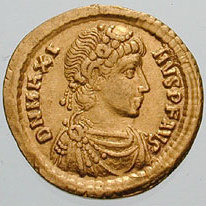
Magnus Maximus was a usurper who conquered part of the
western Roman Empire and became recognized as emperor, albeit for a relatively
short time.
He was probably born in the year 335 in what is now
north-west Spain. He joined the army and served under his uncle, General
Flavius Theodosius, whose son would later become Emperor Theodosius I.
Magnus rose to the status of General and served in
Britannia, where he was active in putting down local uprisings.
Britannia was part of the western empire ruled by Emperor
Gratian from November 375, but his rule was not always accepted with complete
loyalty. When the army rebelled in 383 they declared Magnus Maximus (which
translates as “Great the Greatest”) to be their emperor. He accepted their
nomination and was soon having coins minted that showed winged Victory hovering
over the two emperors – the western one being Magnus and the eastern being
Theodosius.
There were in fact four men (or, to be more accurate, three
men and a boy) who claimed the title of emperor at this juncture. The one who
most concerned Magnus was Gratian, who was the “official” western emperor with
jurisdiction over Gaul and Britannia. Magnus therefore crossed the English
Channel, accompanied by a large number of soldiers whose duties had previously
been to protect Roman Britain from troublesome local tribes.
Many of Gratian’s troops promptly deserted him and he fled
to Lyons, where he was murdered on 25th August.
Magnus Maximus was now in effective control of much of the
western empire, namely Britannia, Gaul and Spain, and he was able to retain
that position for the next five years. What he wanted most was recognition of
his status by his fellow emperors, namely Theodosius and Valentinian II
(Gratian’s half-brother), who was the nominal ruler of Italy, Africa and the
western Balkans, despite being only 12 years old at the time of Gratian’s
death.
Theodosius was willing to recognize Magnus as a co-emperor,
but Valentinian – or rather, his adviser Bishop Ambrose – was not. Magnus had
no choice but to resort to force and he therefore invaded north Italy
(Valentinian was based at Milan) in 386. Valentinian fled eastwards,
accompanied by his mother and sister, and sought refuge with Theodosius.
Theodosius was therefore given the choice of either
supporting his cousin Magnus or the half-brother of the man who had nominated
him for the post of eastern emperor. He was also offered Valentinian’s
extremely attractive sister as his wife, and this was an offer he could not
refuse.
Theodosius therefore marched against Magnus Maximus, who was
completely unprepared for this turn of events. Magnus was captured at Aquileia (near
modern-day Trieste) and executed on 27th August 388, a fate that was
also suffered by his family and close associates.
One important consequence of the short reign of Magnus
Maximus was that the troops he took with him to Gaul did not return to
Britannia. There is some evidence that many of them settled in what is now
Brittany. The result of this was that Britannia was now deprived of much of its
defence force and was therefore subject to incursion by tribes that included
Picts from Scotland, Scots from Ireland and Saxons from northern Europe. Local
chiefs who had formerly relied on Roman protection could no longer do so. The
beginning of the end of Roman Britain can therefore be dated from around this
time.
© John Welford
No comments:
Post a Comment